
A Jigger is a small tool that is used to measure the proper amount of alcohol that should be added to a cocktail. Jiggers can be made of metal, plastic, or glass, and come in all kinds of shapes and sizes. Jiggers are one of the most basic devices that every bartender should know how to use and utilize for making drinks.

The standard jigger is shaped like an hourglass on the end of a rod; two unequal sized opposing cones, with 1 side measuring 1.5oz, which is the size a traditional shot. The smaller side of the jigger is often called a "pony" shot and typically measures 1oz. Actual sizes depend on local laws and customs. Many bar owners prefer their bartenders to use jiggers over the free pour method that can result in bartenders over-pouring or under-pouring cocktails, and the bar eventually losing money. Making Cocktails is technically an art, and to achieve the best tasting cocktails the perfect ratio of spirits to mixers must be used. Home drinkers can also benefit from using jiggers.
1 shot is 1.5 fluid oz or 44,4 millilitres
Pony shot is 1 fluid oz around 30 milliliters
Silver jigger by Ollivant & Botsford London 1901.
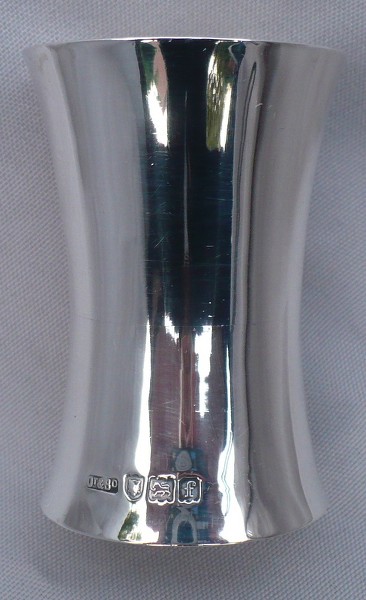
The jigger has clean, smooth feminine lines in a simple beautiful Art Nouveau style.
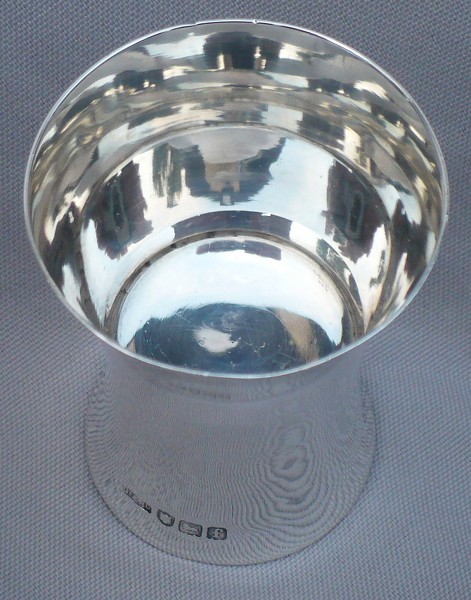

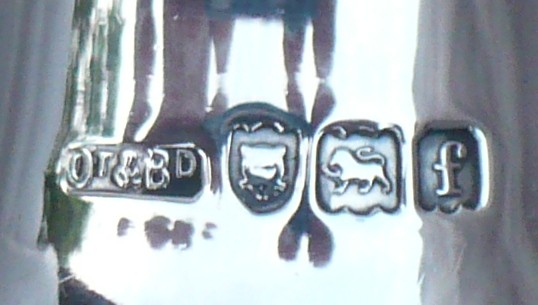

For more information about Ollivant & Botsford registered 1896-2001
https://beta.companieshouse.gov.uk/comp ... ory?page=1
Silver shot cups.
A shot cup is a small cup designed to hold or measure spirits or liquor, which is either drunk straight from the cup ("a shot") or poured into a cocktail.
Gorham Sterling Silver **Stoplight** Graduated Jigger or shot Cup 53 grams Model 354
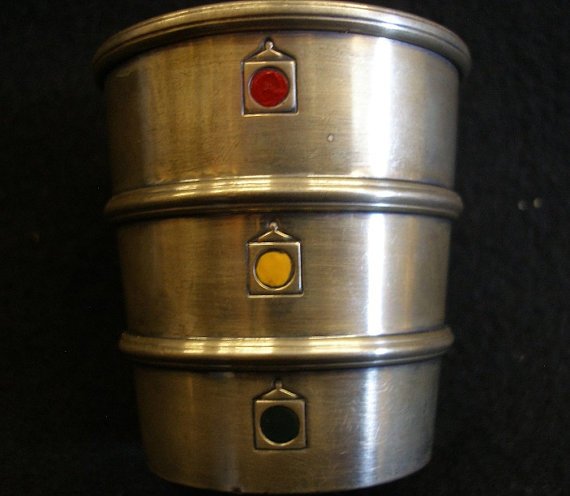
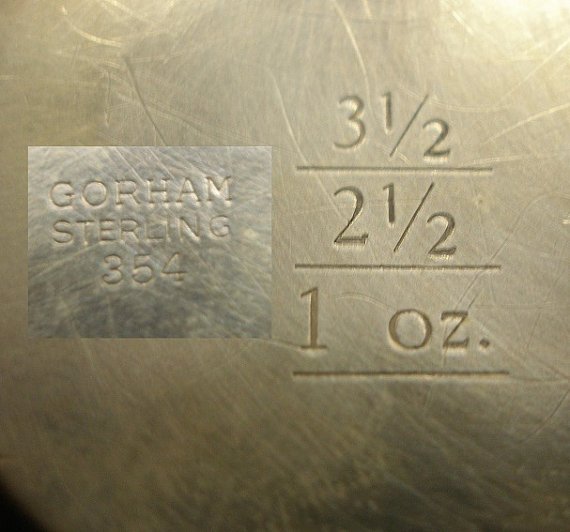
Shot glass.
March 5, 2010 By Jason
The term “shot glass” is relatively common and just about everyone knows what a shot glass is. In fact, shot glasses make great collectable souvenir items to remember a vacation or a special occasion. They often are printed with a bar’s name or a brand of whiskey and can even be found in fun shapes like a cowboy boot or a mini beer mug. They can be short and squat or tall and thin. Of course, besides being collectables, they serve a purpose. They are used to measure liquor to be used in a cocktail or you can simply drink the liquor straight from the shot glass.
There are many other names for shot glasses. Earlier they were referred to as jiggers or ponies to measure out a set amount of liquor. A jigger is bigger than the shot glass. They can also be called whiskey glasses or whiskey tumblers since as long ago as the 18th century whisky was typically served in these smaller glasses. They usually hold one to two ounces of alcohol.
The word “shotglass” or term “shot glass” was first used in the 1940s and it was in a news story that discussed ways to regulate the size of a shot of liquor in the restaurants and bars in New York City. The term didn’t become widely used until much later than this.
There are many unsubstantiated stories about how the shot glass came to be, each originating long before the word was ever found in any printed material. Some of the stories don’t even have to do with the serving or drinking of alcohol.
One supportable fact is that glasses called a “whiskey” were given out by American distilleries to advertise their brands beginning in the late 19th century until prohibition temporarily squelched the liquor industry. For collectors, these glasses are rare and can be worth $100 or more these days. There are also old shot glasses known as “Depression glass” that actually came as part of sets of dinnerware during the 1920s, ‘30s, and ‘40s.
Substantiated or not, many of the old stories about the origin of the shot glass are, at the very least, interesting. One of the most well-liked of these stories is that the shot glass came to be in the saloons of the of Old West. After all, what Western movie worth its salt doesn’t have at least one scene with the cowboys coming in off the trail and slamming a few shots of whiskey out of small shot glasses? The story goes that cowboys would trade one cartridge for a little bit of alcohol. There are several problems with this story. First of all, most of the saloons in those days would never have been able to afford to have this new style of glass made just for this purpose. Plus, alcohol was much more expensive than one cartridge.
One relatively far-fetched story claims that small glasses were used at the dinner table in which to place or spit any lead shot still in the meat from the shotgun used to kill the game. Most “shot glass historians” believe that there may have been a glass used for this purpose, but don’t believe that the shot glass as we know it originated from this.
Others say that the shot glass was originally used to support quill pens over 100 years ago. Supposedly, small glasses with thick walls were filled with BBs or lead shot and when the feather quill was not in use it would be placed in the glass to hold it up straight. Skeptics say that a glass used for such a purpose would have to have been wide at the base and thin at the top in order to support the pen, not wide at the top and thin at the base like the typical shot glass.
History most often supports the origin of the glass stemming from prohibition and the Depression as talked about earlier in this article. Whatever you choose to believe is up to your. After all, it does not affect your enjoyment of being a collector or simply savoring a shot of whiskey “neat” or a jigger of tequila with salt and a wedge of lime.
A Brief History of Glass:
The shot glass, as we know it today, has gone through an interesting evolution throughout human history, influenced by many cultures including those in Africa, China and Europe.
1496 B.C. History of Glass Rule
Evidence has been found in ancient Egyptian ruins supporting the theory that people made and used glass over 3500 years ago. It is known that the Egyptians used a process referred to as core-forming. Clay was shaped and used as a base over which hot glass was poured. Mesopotamians invented and refined two other processes, casting and polishing glass. Glass artifacts created with these methods were primarily intended for wealthy patrons.
50 B.C.- 400 A.D. History of Glass Rule
Roman craftsmen invented the art of glass blowing. For the first time, ordinary citizens were granted access to glass vessels. Surface decoration was soon added to the glass to make the pieces more distinctive. Cutting, engraving, abrading and enameling motifs that illustrated chariot battles and gladiators, gods, and grapes make these containers readily identifiable.
During this same time period, the Chinese were delving into glass making as well, creating beautiful glass beads, jade figurines and the finest porcelain objects in the world.
700-1401 A.D. History of Glass Rule
Islamic glass artisans focused their skills on the art of relief cutting. The best-known example of this type of work was "cameo-cut glass." Only the wealthiest citizens could afford the luxury of owning these beautiful items. Enameling was less expensive and done on bowls, bottles and glasses that were purchased and used by commoners.
1100 A.D. History of Glass Rule
With the waning of the Dark Ages, Europe entered a new age of enlightenment and glass played an integral part in this significant period in history. By mixing various materials with silica, glass makers found they could create intense, vivid colors and stained glass was born. The Church became an affluent patron of the arts, building incredible Gothic cathedrals filled with beautiful stained-glass windows and mosaics.
1450-1700 A.D. History of Glass Rule
By the 15(th) century the glass industry was well established in Venice. Venetian glass makers began experimenting and refining the art of colored glass thus making Venice central to the glass industry in Europe. They reintroduced the use of gold in decoration, enamel and graffito (scratched gold-leaf). One of the most outstanding contributions, originated by Angelo Barovier, was the development of "cristallo" (colorless glass). They were also the first to use diamond point engraving introduced by Vincenzo D'Angelo. These fine Venetians artisans dominated the glass industry well into the 17(th) Century.
1500-1750 A.D. History of Glass Rule
German and Bohemian glass makers began experimenting with clear glass, eventually creating a product more durable than thin, delicate Venetian glass that was more easily cut on a rotary stone or copper wheel (1725). Designs that were once enameled on the surface of drinking vessels now could be engraved. As a result of the research and workmanship of these skilled craftsmen, the center of the glass making industry slowly shifted away from Venice to Western Europe.
Mid 1600's History of Glass Rule
English glass makers gained a significant foothold on the market by creating a dark green glass used to make "black bottle", so durable that it rarely broke in shipping. For more than a hundred years England was the leader in glass bottle production in the western world.
1676 A.D. History of Glass Rule
An Englishman, George Ravenscroft perfected a formula for lead glass. This afforded glass makers the ability to create more intricate designs, such as new stem formations and teardrops. This heavier glass also encouraged the English to experiment with cutting techniques to take full advantage of the refracting properties intrinsic in the lead formula.
1690 A.D. History of Glass Rule
William of Orange passed a law that lifted taxes on distilled spirits and encouraged development and expansion of this industry. Stills sprang eternal. Newly discovered gin became the drink of choice for the middle and lower classes, bringing with it the demand for appropriate glassware. Instead of the larger bowl-shaped wine goblets used by the upper classes, much smaller glasses were needed to accommodate the more potent distilled spirits. Dram glasses used for "chugging" several toasts of rum, brandy, whiskey or gin, were cheaply made. Because they broke so easily, much sturdier firing glasses were created. They had to be strong enough to withstand the abuse of being pounded on tavern tables giving off sounds much like musket fire, hence the name "firing glasses."
1780 A.D. History of Glass Rule
When England lifted the ban on exporting to Ireland, the trade routes bustled once again. Irish glass was basically identical to English glass. Major Irish cities producing glass included Dublin, Belfast, Cork, and best known, Waterford. America imported all types of glassware from England and Ireland well into the 19(th) century.
1800's to date History of Glass Rule
American glass companies began gearing up. Ideas such as geometric pattern cutting, black bottle, and decoration techniques were borrowed from Europe. Many of the skilled craftsmen who worked in the newly established glass factories were European immigrants.
Glass has evolved through advancing technologies. It enriches our lives daily with its numerous uses that 15(th) century Venetian masters never would have imagined. Those include an array of products from finely ground lenses in space rovers, high-powered telescopes, exquisite dinnerware, crystal chandeliers, finely crafted lights and, of course, shot glasses which are an American adaptation.
(The Definitive Guide to Shot Glasses by Mark Pickvet; Antique Publications, 1992.)
One Definition of a Shot Glass History of Glass Rule
For all intents and purposes, shot glasses may be defined as "whiskey tumblers which are small vessels made of glass designed for drinking distilled spirits in small amounts." The sizes may vary slightly, but as a rule shot glasses should be no shorter than 1-3/4 in. and no taller than 3 in.; consequently, the volume ranges from one to two ounces as dictated by the height.
"Real" shot glasses don't have stems (like champagne or wine glasses) or handles (like mugs or steins) or feet (like pilsners or snifters glasses). They are made of glass, not metal or plastic. Shot glasses usually taper outwards, the diameter being greatest at the top of the glass, but there are exceptions. Some have no taper at all, while others have a base diameter greater than the top. Traditional tumblers are round. There are some square shot glasses, 2-1/2 in. tall, that hold 2 ounces.
The history of the standard shot glass began about 100 years ago and today many variations of the shot glass are common. Collectors find glass, metal, plastic, ceramic and other materials being used for a endless variety of styles and colors. The taller glasses like some of the tall Hard Rock Cafe glasses, are technically not shot glasses and are usually referred to as "shooters."
(The Definitive Guide to Shot Glasses by Mark Pickvet; Antique Publications, 1992.)
Oel.